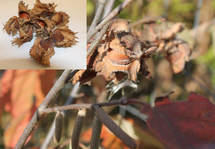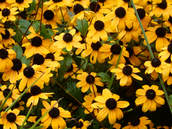In Bloom Archives

American Hazelnut - Corylus americana: If you like unusual seed capsules, the American Hazelnut is for you. With a shrubby growth habit, the hazelnut works well in landscaping. Preferring full sun, it is a medium to fast growing species, obtaining 10 to 15 feet in height and width. Although it can be trained to take on the form of a small tree, it is typically a multi-stemmed clump.
Catkin-type flowers appear in spring and edible nuts mature in September/October. It is best planted in multiples to ensure cross-pollination. Nuts are encased in an unusual, sculptural capsule and are enjoyed by wildlife of all kinds – squirrels, deer, birds, turkeys to name a few.
The hazelnut adapts well to a range of environments, but does best on well-drained loams with full sun.
Catkin-type flowers appear in spring and edible nuts mature in September/October. It is best planted in multiples to ensure cross-pollination. Nuts are encased in an unusual, sculptural capsule and are enjoyed by wildlife of all kinds – squirrels, deer, birds, turkeys to name a few.
The hazelnut adapts well to a range of environments, but does best on well-drained loams with full sun.
Black Tupelo (Black Gum) - Nyssa sylvatica: The Black Gum or Black Tupelo tree's leaves are in full glory right now - the foliage first turns purple and then an intense bright scarlet red. This interesting tree growing to 50 ' tall can be found from New England to Florida and is tolerant of a wide variety of growing conditions. It has a straight trunk with branches coming out at right angles and bark that looks like alligator hide. Small, greenish-white flowers appear in spring on long stalks. Although the flowers are not showy, they are an excellent nectar source for bees. The flowers are followed by half inch, dark purple drupes that are an important food source to many birds including robins.
Since it has a taproot, it is best propagated by seed , but beware that deer are extremely fond of the leaves on seedlings and saplings.
The wood of the Black Tupelo is extremely hard, and it is many times passed over when timbering occurs because of that.
Since it has a taproot, it is best propagated by seed , but beware that deer are extremely fond of the leaves on seedlings and saplings.
The wood of the Black Tupelo is extremely hard, and it is many times passed over when timbering occurs because of that.

Brown Eyed Susan - Rudbeckia Triloba: Sporting abundant golden yellow daisy-like flowers with black centers that fade to brown, R. triloba blooms in August and continues until frost. The cheery flowers are 1-2 inches across and bloom on branching stems, forming a mass of color. Typically seen along roadsides, in breaks in wooded areas, and open meadows or fields, R. triloba tolerates most conditions and is relatively drought tolerant. It is a biennial, blooming in the second year, but readily self-seeds so you are never in short supply. Plants are 3-5 feet tall and bushy unless crowded out. It makes an excellent cut flower – one stem is a whole bouquet. It is great for naturalizing, or in the garden where it pairs nicely with native grasses and asters for fall color. Easily propagated from seed, it is also a good pollinator plant.Abundant yellow daisy-like flowers with black centers that fade to brown, R. triloba blooms in August and continues until frost.
Flowers are 1-2 inches across and bloom on branching stems, forming a mass of yellow flowers. Although it prefers moderate moisture, R. triloba tolerates most conditions and is actually pretty drought tolerant. It is a biennial, blooming in the second year, but is readily self-seeds so you are never in short supply. Plants are 3-5 feet tall and bushy unless crowded out. It makes an excellent cut flower – one stem is a whole bouquet. It is great for naturalizing, or in the garden where it pairs nicely with native grasses and asters for fall garden color. Easily propagated from seed it is also a good pollinator plant.
Flowers are 1-2 inches across and bloom on branching stems, forming a mass of yellow flowers. Although it prefers moderate moisture, R. triloba tolerates most conditions and is actually pretty drought tolerant. It is a biennial, blooming in the second year, but is readily self-seeds so you are never in short supply. Plants are 3-5 feet tall and bushy unless crowded out. It makes an excellent cut flower – one stem is a whole bouquet. It is great for naturalizing, or in the garden where it pairs nicely with native grasses and asters for fall garden color. Easily propagated from seed it is also a good pollinator plant.